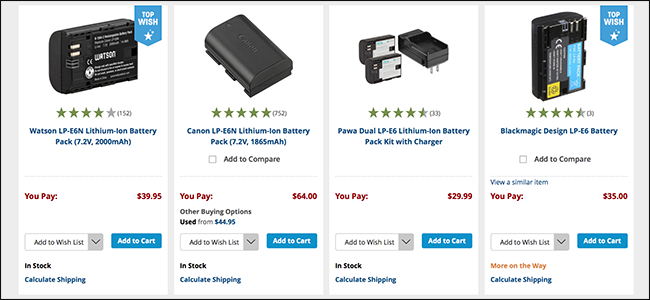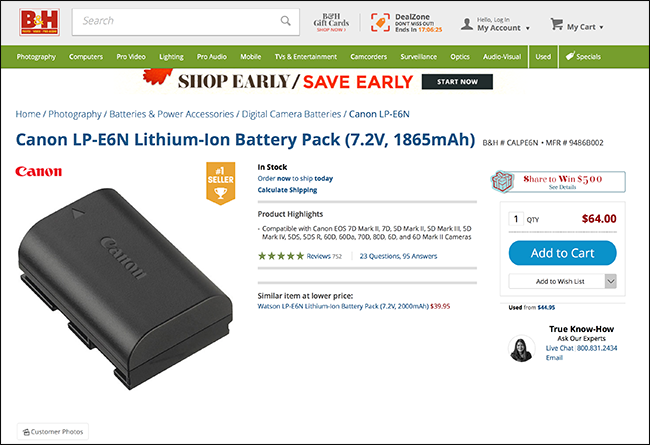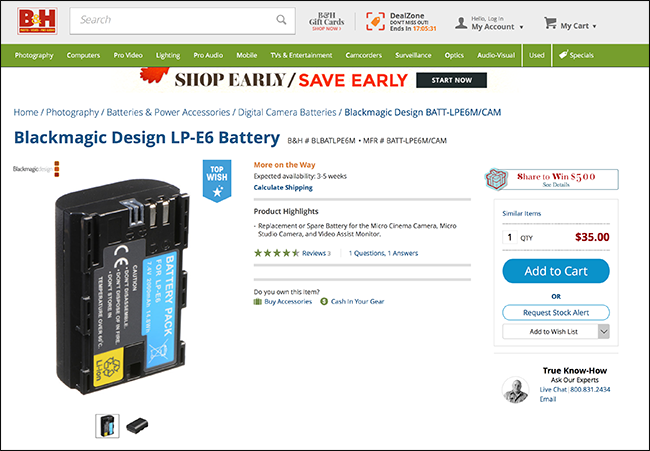Quick Links
Batteries are dangerous—they’re practically a bomb—so you need to be careful when you buy them. Sure, they’re not likely to take down an airliner but a bad battery could definitely damage your camera. It also might not work as expected. Here’s what you need to know about buying batteries for your DSLR or mirrorless cameras.
First-Party and Third-Party Batteries
The battery that came with your camera is called a “first-party” battery because it was made by the manufacturer of the camera (or at least by a licensee they supervise). It’s the battery with which your camera is designed to work. You can buy additional first-party batteries but they tend to be quite expensive.
Third-party batteries are made by a company other than your camera’s manufacturer. They range from high-quality batteries made by reputable camera manufacturers—like this third party battery made by Blackmagic—to cheap Chinese knock-offs, churned out by factories where safety standards and testing are foreign concepts. It’s a pretty wide range.
The (Potential) Problems With Third Party Batteries
With first-party batteries, you always know what you’re getting (as long as you’re really getting a first party battery and not a counterfeit; more on that later). It’s the exact same as the one that came with your camera when you bought it. With third-party batteries, however, things aren’t quite as certain.
Third-party batteries are almost always cheaper than original batteries. Canon’s LP-E6N battery costs $64 while Blackmagic’s—presumably high quality—replica costs $35. That’s a pretty steep difference. I’ve seen batteries from less reputable manufacturers cost as little as $10—and no, I won’t link to them.
The problem here is that money has to be saved somewhere. It definitely doesn’t cost Canon $60 to make a battery, but it costs them some fraction of that. Good third-party manufacturers deliberately make less profit to undercut Canon. Bad manufacturers, however, will just cut costs from materials, testing, design, and other places that reduce the overall quality of the battery.
In the best case scenario, you end up with a battery that might not hold as much charge, won’t last as long, or maybe feels a bit plasticky but otherwise works as expected. There’s also a chance you might end up with a total dud that won’t work at all or won’t charge with the official charger. In the worst case, as we’ve seen with USB cables, you could get a battery that actively damages your camera.
Now, I’m not saying all third-party batteries are bad. The odds are that they’ll work just fine—and the odds are even better if you go with a reputable manufacturer—but you do need to be careful, especially with where you buy them from.
Don’t Buy from Amazon
Amazon has a lot of problems with scams at the moment—even our own Chris Hoffman was caught by one. Most of the issues are with “Fulfilled by Amazon” sellers; Amazon is doing very little to police their inventory and make sure that they’re not selling shoddy products or counterfeits. For most things, buying from Amazon is fine, but for batteries for your prized camera, you need to be a little more careful.
We’ve considered it and, honestly, we recommend not buying any camera batteries from Amazon—including first-party batteries. The chance that you’ll get a bad third-party battery or a counterfeit first-party battery is just too high.
Instead, you should buy batteries from your local camera shop or a high quality, dedicated online photo store like B&H. Even if you decide to go with a third-party battery, at least you know it’s been ordered in by someone who knows about cameras. A good camera shop is much less likely to sell you a problem product than Amazon’s open, anyone can sell, marketplace.
Personally, I prefer to stick with first-party batteries but that’s a luxury I have because taking photos is a big part of my job. If you need an extra battery but don’t want to pay top dollar, buy a third-party battery—just don’t go with the cheapest one you can find on Amazon.



